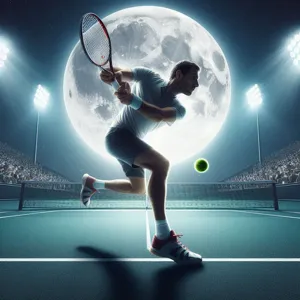Tennis is not just a test of physical prowess; it’s a mental battlefield where strategy, resilience, and skill collide.
Facing a strong opponent can be an intimidating experience, but with the right approach, you can turn that challenge into an opportunity for growth and triumph. Whether you’re a seasoned player looking to refine your game or a newcomer eager to elevate your skills, mastering the art of competition is key to becoming a formidable athlete on the court. In this blog post, we’ll explore top tips and proven strategies to help you outsmart and outplay even the toughest adversaries. From honing your mental toughness to developing tactical shot selections, prepare to transform your game and boost your confidence as we delve into the intricacies of beating a strong tennis opponent. Get ready to unlock your full potential and embrace the thrill of competition!
1. Understanding Your Opponent’s Game Style

Understanding your opponent’s game style is the cornerstone of formulating a strategy to overcome their strengths and exploit their weaknesses. Each player brings a unique set of skills to the court, influenced by their playing style, physical attributes, and preferences. To gain the upper hand, you must first observe and analyze these elements carefully.
Begin by identifying whether your opponent is an aggressive baseliner, a serve-and-volley player, or a counterpuncher. Aggressive baseliners thrive on hitting powerful groundstrokes from the back of the court, aiming to dictate the tempo of the game. If you’re facing one, consider playing with depth and precision, forcing them to adjust their rhythm. A serve-and-volley player, on the other hand, seeks to take control of the net, so you may want to focus on passing shots and lobbing effectively to keep them on their toes.
Additionally, pay attention to your opponent’s footwork and shot selection. Are they comfortable hitting forehands or do they struggle with backhands? Do they tend to favor certain angles or court positions? By noting these patterns, you can anticipate their next move, giving you a tactical advantage. It’s also crucial to assess their mental game. Are they easily rattled by mistakes, or do they remain composed under pressure? Understanding their psychological resilience can help you devise a plan to exploit any vulnerabilities during critical moments in the match.
Take the time to scout your opponent, whether through previous match footage or during warm-ups. This not only allows you to form a clearer picture of their game style but also builds your confidence as you prepare to face them. Remember, knowledge is power in tennis; by understanding your opponent’s game style inside and out, you’ll be better equipped to adapt your own strategy, outmaneuver them on the court, and, ultimately, emerge victorious.
2. Analyzing Your Own Strengths and Weaknesses
When it comes to facing a strong tennis opponent, understanding your own strengths and weaknesses is a crucial step in crafting an effective game plan. Self-analysis allows you to approach your match with clarity and confidence, enabling you to leverage your advantages while minimizing the impact of your shortcomings.
start by taking a close look at your playing style. Are you an aggressive player who thrives on taking control of the net, or do you prefer to play from the baseline, relying on consistent groundstrokes? Evaluate your shot selection—are your serves powerful and accurate, or do you struggle with placement? Perhaps your forehand is your secret weapon, while your backhand needs some work. Identifying these elements will help you recognize what you do best and what requires more attention.
Next, consider your physical fitness. Are you quick on your feet, able to chase down balls with agility, or do you find yourself fatigued after long rallies? Your stamina can be a game-changer, so acknowledging your conditioning level can influence your strategy during the match. If you’re not as fit as your opponent, focus on making smart shot selections that conserve energy without sacrificing effectiveness.
Emotional resilience is another vital aspect of your self-assessment. How do you handle pressure situations? Do you thrive under stress, or do nerves tend to get the best of you? Understanding your mental game will help you prepare for challenging moments during the match, allowing you to implement techniques to stay calm and focused.
By analyzing your own strengths and weaknesses, you can establish a tailored approach to your match-up. Highlight your strengths to dominate points, while developing strategies to mitigate your weaknesses—perhaps incorporating more slice serves if your opponent struggles with them or mixing up your shots to keep them guessing. This self-awareness not only enhances your performance but also gives you a competitive edge against even the toughest rivals. Embrace the journey of self-discovery, and you’ll find yourself better equipped to take on any challenge on the court.
3. Developing a Strategic Game Plan

In the world of competitive tennis, having a strategic game plan is akin to having a secret weapon in your arsenal. It’s not just about hitting the ball hard or having impressive footwork; it’s about understanding your opponent’s strengths and weaknesses and leveraging your own skills to exploit those gaps. Developing a strategic game plan requires a careful analysis of both your style of play and that of your opponent.
Begin by observing your opponent’s tendencies. Do they favor their forehand, or are they particularly adept at volleying? Are they prone to double faults under pressure? By identifying these patterns, you can craft a game plan that plays to your advantages. For example, if your opponent struggles with backhand returns, aim to direct your shots to that side, forcing them into uncomfortable positions.
Next, consider your own strengths. Are you a powerful server? Use that to your advantage by serving wide to open up the court. If you have exceptional speed, you might want to engage in longer rallies, wearing your opponent down. A well-rounded game plan will incorporate various strategies, such as changing the pace of the game, mixing up your shot selections, and strategically using the drop shot to keep your opponent guessing.
Finally, remember that flexibility is key. As the match progresses, be prepared to adapt your strategy based on how your opponent responds. A successful player remains calm and adjusts their plan on the fly, whether that means shifting from aggressive baseline rallies to net play or vice versa. By developing a thoughtful and adaptable game plan, you’ll position yourself not only to compete but to thrive against even the strongest opponents.
4. The Importance of Mental Toughness
Mental toughness is often the unsung hero of competitive tennis, serving as the backbone of a player’s performance when the pressure mounts. In a game where every point counts and emotions can swing like a pendulum, your ability to maintain composure can be the difference between victory and defeat.
Picture this: you’re in the third set, battling against a formidable opponent who seems to find their rhythm with every stroke. The crowd is buzzing, the stakes are high, and fatigue is beginning to set in. It’s in these moments that mental resilience becomes your greatest ally. Cultivating a strong mental game means developing strategies to manage anxiety, maintain focus, and boost confidence, even when the odds seem stacked against you.
Techniques such as visualization, where you picture yourself executing perfect serves and winning points, can be invaluable. This mental rehearsal not only enhances your performance but also reinforces your belief in your abilities. Additionally, incorporating mindfulness and breathing exercises can help ground you during tense moments, allowing you to stay present and avoid being overwhelmed by the match’s intensity.
Furthermore, embracing a positive mindset is crucial. Instead of dwelling on past mistakes or worrying about the outcome, focus on the process. Each point offers a new opportunity to play your best, and by shifting your attention to what you can control—your effort, strategy, and attitude—you fortify your mental toughness.
Remember, even the most skilled players can falter under pressure, but those with strong mental fortitude are often the ones who rise to the occasion. By nurturing your mental toughness, not only will you perform better against strong opponents, but you’ll also find a deeper enjoyment in the game itself, allowing you to play not just to win, but to thrive.
5. Mastering the Art of Shot Selection

Mastering the art of shot selection is one of the most pivotal skills you can develop when facing a strong tennis opponent. It’s not just about hitting the ball hard; it’s about hitting the right shot at the right time. Understanding the nuances of your opponent’s strengths and weaknesses can significantly influence your decision-making on the court.
Start by observing your opponent’s playing style. Do they struggle with high balls? Are they less agile on their backhand side? Tailoring your shot selection to exploit these weaknesses can give you the edge you need. For instance, if you notice that your opponent tends to falter under pressure, consider employing a mix of aggressive shots and well-placed lobs to keep them off balance.
Additionally, be mindful of the court position. Hitting a deep shot when your opponent is positioned close to the net can force them into an uncomfortable position, while a drop shot can catch them off guard if they’re standing too far back. Varying your shot depth and angles adds an element of surprise and makes it difficult for them to anticipate your next move.
Moreover, don’t underestimate the importance of patience. Strong opponents often thrive on fast-paced rallies, so taking a moment to set up the perfect shot can be invaluable. Instead of rushing your shots, focus on maintaining control and executing with precision.
Finally, practice makes perfect. Spend time refining your shot selection during drills and practice matches. The more comfortable you are with your repertoire of shots, the more confident you will feel in making quick decisions during a match. Remember, effective shot selection is an art form that combines strategy, awareness, and execution, all of which can turn the tide in your favor against even the toughest opponents.
6. Utilizing Effective Footwork and Positioning
Mastering effective footwork and positioning can make the difference between a good player and a great one, especially when facing a strong opponent. In tennis, your ability to move swiftly and accurately around the court is crucial for both offensive and defensive strategies. Picture your favorite pro athlete gliding gracefully across the court, effortlessly reaching for every shot—that’s the power of well-executed footwork.
First and foremost, focus on your stance. A solid, balanced position enables quicker reactions and smoother transitions. Keep your feet shoulder-width apart, with your weight slightly forward, ready to spring into action. As you anticipate your opponent’s next move, visualize the angles they might exploit and adjust your stance accordingly. This proactive approach allows you to be a step ahead, rather than scrambling to catch up.
In practice, incorporate drills that enhance your lateral movement and agility. Shuttle runs, ladder drills, and cone exercises can help sharpen your foot speed and coordination. The key is to develop a lightness in your feet—think of yourself as a dancer, maintaining fluidity and grace as you move. Remember, the quicker you can get into position, the more time you’ll have to execute your shot.
Positioning is equally vital. Always aim to place yourself in the optimal spot to intercept the ball. This involves not just moving towards the ball but also predicting its trajectory. Pay attention to your opponent’s body language and racket angle as they prepare to hit. If you can read their intentions, you can position yourself accordingly, allowing for a more effective response.
Moreover, practice hitting from various positions on the court. This will not only enhance your adaptability but will also give you the confidence to play aggressively, regardless of where the rally takes you. When you can control your positioning, you’ll find it easier to dictate the pace of the match and dictate the play to your advantage.
By honing your footwork and positioning, you’ll not only enhance your overall play but also create a psychological edge over your opponent. A well-positioned player is a formidable adversary, capable of turning the tide in their favor with every match. So lace up those shoes, hit the court, and start mastering the art of movement—your next victory is just a step away!
7. Enhancing Your Serve for Competitive Advantage

Enhancing your serve can be a game-changer when facing a strong opponent. The serve is not just a mere formality; it’s the first shot of every rally and can set the tone for the entire match. A powerful and well-placed serve can give you a competitive edge, often catching your opponent off guard and forcing them into a defensive position from the very beginning.
To elevate your serving game, start by focusing on your technique. A solid stance, a fluid motion, and precise timing are essential components of a successful serve. Break down the mechanics: ensure your grip is firm yet relaxed, your toss is consistent, and your follow-through is smooth. Consider incorporating different types of serves into your repertoire, such as flat, topspin, and slice serves. Each variation can keep your opponent guessing and disrupt their rhythm.
Moreover, don’t underestimate the psychological aspect of serving. A confident serve not only intimidates but also instills doubt in your opponent’s mind. Practice serving under pressure, simulating match scenarios where you need to perform crucial serves at critical moments. This will help you become accustomed to the mental strain while reinforcing your muscle memory.
Finally, analyze your opponent’s weaknesses. If they struggle with high balls, opt for a kick serve that bounces high and forces them out of their comfort zone. If they have a weaker backhand, direct your serves towards that side. By tailoring your serve to exploit your opponent’s vulnerabilities, you can gain a significant advantage right from the start.
Incorporating these strategies into your training can transform your serve from a routine part of the game into a powerful weapon, setting the stage for a successful match against even the toughest of opponents.
8. Practicing Return of Serve Techniques
Mastering the art of returning your opponent’s serve is crucial in gaining an advantage on the court, especially when facing a strong competitor. A formidable serve can set the tone of a match, but with the right techniques, you can turn this challenge into an opportunity. Start by focusing on your positioning; stand a few feet behind the baseline to give yourself ample time to react to the incoming ball. This allows you to gauge the speed and spin more effectively, giving you the chance to plan your return.
Next, refine your grip and stance. Whether you prefer a continental grip for versatility or an eastern grip for more power, ensure that you are comfortable and confident in your choice. As the server tosses the ball, keep your eyes locked on it and anticipate the type of serve they are delivering—whether it’s a flat serve, slice, or kick serve. This anticipation can be the key to timing your swing just right.
Incorporating drills into your practice sessions can also elevate your return game. Work on specific return drills that simulate different types of serves. For instance, practice stepping into the court for powerful returns or developing your slice return to redirect the ball back with finesse. Don’t forget to focus on your footwork; quick, agile movements are essential for positioning yourself effectively to make solid contact with the ball.
Lastly, remember that mental strength plays a significant role in returning serves. Stay composed and focused, even when faced with the pressure of a powerful server. Visualize yourself successfully returning serves and adopt a positive mindset. By enhancing your return of serve techniques, you’ll not only neutralize your opponent’s strengths but also take control of the rally, setting the stage for a victorious match.
9. Staying Physically Fit and Agile
Staying physically fit and agile is a cornerstone of excelling on the tennis court, especially when facing a formidable opponent. Tennis is not just a game of skill and strategy; it demands a high level of physical conditioning that allows you to respond quickly and effectively to your opponent’s every move. The agility to dart across the court, the endurance to power through long rallies, and the strength to execute powerful serves and volleys all stem from a well-rounded fitness regimen.
Incorporating a mix of cardiovascular exercises, strength training, and flexibility workouts into your routine is essential. Running, cycling, or swimming can significantly boost your stamina, while plyometric exercises like box jumps or lateral bounds enhance your explosive power and speed. Additionally, strength training targeting your legs, core, and upper body will help you generate more force in your shots and maintain balance during plays.
Flexibility also plays a crucial role in preventing injuries and improving your range of motion. Regularly practicing yoga or dynamic stretching can help you achieve better flexibility, allowing for smoother movement and quicker recovery between points. Moreover, agility drills—such as ladder drills or cone sprints—can sharpen your footwork, making it easier to position yourself effectively for every shot.
Ultimately, staying physically fit and agile not only gives you a competitive edge but also builds your confidence on the court. When you feel strong and capable, you’re more likely to maintain focus and composure, even when the pressure intensifies. So, prioritize your fitness, and you’ll find that your performance against even the toughest opponents will improve dramatically.
10. Learning to Control Your Emotions on the Court
Mastering the art of controlling your emotions on the court is a crucial yet often overlooked element of competitive tennis. The pressure of a match can evoke a whirlwind of feelings—excitement, frustration, anxiety, and even anger—all of which can influence your performance and decision-making. To truly excel against a strong opponent, you must learn to harness these emotions rather than let them dictate your game.
First and foremost, recognize that tennis is as much a mental battle as it is a physical one. When faced with a tough opponent, you might feel the heat of the moment pressing down on you. In these cases, take a deep breath and center yourself. Breathing techniques can be incredibly effective; try inhaling deeply for a count of four, holding for four, and exhaling for four. This simple practice can help ground you, allowing you to focus on the next point instead of the last one.
Another key strategy is to develop a consistent pre-serve ritual that calms your nerves and prepares you mentally for each point. Whether it’s bouncing the ball a certain number of times, adjusting your grip, or visualizing a successful serve, these small actions can create a sense of familiarity and control, helping ease the emotional intensity of the match.
Additionally, maintaining a positive self-talk can serve as your mental coach during challenging moments. Replace negative thoughts with affirmations that reinforce your skills and resilience. Phrases like “I can do this” or “I’ve trained for this” can shift your mindset from one of doubt to one of determination.
Finally, accept that mistakes are part of the game. Strong opponents will challenge you, and you will inevitably face setbacks on the court. Instead of dwelling on errors, learn to adopt a growth mindset; view each challenge as an opportunity to improve. Embrace the learning experience, and allow it to fuel your drive for success rather than diminish it.
By mastering your emotions, you not only enhance your performance but also build a mental fortitude that will serve you well against any opponent. The ability to remain calm and composed under pressure is what separates the good players from the great ones, allowing you to rise to the occasion when it matters most.
11. Leveraging Visualization and Positive Thinking
Visualization and positive thinking are powerful psychological tools that can give you the edge you need when facing a formidable tennis opponent. Picture this: before stepping onto the court, you take a few moments to close your eyes and vividly imagine yourself executing your best shots, moving effortlessly, and outsmarting your rival at every turn. This mental rehearsal not only boosts your confidence but also prepares your mind and body for the challenges ahead.
Start by creating a clear mental image of your ideal performance—imagine the feel of the racket in your hand, the sound of the ball hitting the strings, and the satisfying thud as it lands exactly where you intended. Visualizing these scenarios helps reinforce muscle memory, making it easier to replicate those successful moments in a high-pressure situation.
In tandem with visualization, cultivating a mindset of positive thinking can transform your approach to the game. Instead of allowing self-doubt or fear of failure to creep in, focus on affirming your strengths and abilities. Remind yourself of past victories and breakthroughs, no matter how small; these memories serve as a reservoir of strength and motivation. Using positive affirmations, like “I am prepared and capable,” or “I thrive under pressure,” can help shift your mindset and keep negative thoughts at bay.
Additionally, practice mindfulness techniques to help you stay centered and calm during the match. By focusing on your breath or the rhythm of your movements, you can maintain a sense of control, even when the stakes are high. Remember, tennis is as much a mental game as it is a physical one, and mastering visualization and positive thinking can make all the difference against a strong opponent. Embrace these strategies, and watch your confidence soar as you step onto the court, ready to conquer any challenge that comes your way.
12. Adapting During the Match: Flexibility in Strategy
In the heat of a tense tennis match, the ability to adapt your strategy on the fly can be a game-changer. While preparation and practice are essential, the true test of a player’s skill comes when they face a formidable opponent who can exploit weaknesses and challenge their game plan. Flexibility in strategy means being willing to shift your approach based on the unfolding dynamics of the match.
Start by paying close attention to your opponent’s strengths and weaknesses. Are they consistently returning your serves with power? Consider mixing up your serve placements, adding spins, or incorporating a slice to throw them off balance. If you notice they struggle with low balls, adjust your shots accordingly to keep them on their toes. This type of situational awareness allows you to take command of the match, rather than being reactive to your opponent’s moves.
Additionally, don’t hesitate to change your playing pace. If you feel the rhythm of the match is favoring your opponent, introducing a slower game tempo can disrupt their flow. Use longer rallies to dictate the pace and tire them out, allowing you to seize control during crucial points.
Communication with your coach, if available, can also provide fresh insights and strategies. Sometimes, an external perspective can identify patterns you may not have recognized in the heat of competition.
Finally, remember that mental flexibility is just as important as physical adaptability. Stay calm and composed, allowing yourself the freedom to experiment with new strategies without the fear of making mistakes. This mindset can help you not only endure the challenges of facing a strong opponent but potentially outsmart them, turning the tide in your favor. By mastering the art of adaptability, you’ll enhance your competitive edge and become a more formidable player on the court.
13. Importance of Recovery and Rest
In the fast-paced world of tennis, where each match can feel like an intense battle of wills and skills, the importance of recovery and rest cannot be overstated. Many players focus so heavily on their training and strategies that they overlook one of the most critical elements of peak performance: allowing the body to recuperate and recharge.
After a grueling match or a tough training session, your muscles are not just fatigued; they are in a state of microtrauma that requires time and care to heal. This is where rest comes into play. Prioritizing recovery periods in your training schedule is essential for maintaining stamina and preventing injuries. It’s during these restful moments that your body rebuilds and strengthens itself, enhancing your overall performance the next time you step onto the court.
Incorporating active recovery methods, such as light stretching, yoga, or even a leisurely swim, can promote blood flow and alleviate soreness while keeping you engaged. Additionally, consider the value of proper nutrition and hydration in your recovery routine. Fueling your body with the right nutrients post-match aids in muscle repair and replenishes energy stores, ensuring you’re ready for your next challenge.
Sleep, too, plays a pivotal role. Quality rest is not just a luxury; it’s a necessity for cognitive function, focus, and physical conditioning. Aim for a consistent sleep schedule, allowing yourself adequate hours of restorative sleep to reset both your mind and body.
Remember, in the game of tennis, even the most skilled players need time to recover. By valuing and integrating rest into your training regimen, you’ll not only enhance your performance against strong opponents but also foster a long and healthy tennis career.
14. Seeking Feedback and Coaching for Improvement
Improving your game isn’t a solitary journey; seeking feedback and coaching can be a transformative step toward mastering the art of tennis. While self-reflection is valuable, the insights of a seasoned coach can illuminate areas of improvement that you may not even realize exist. A good coach can help you refine your technique, identify weaknesses in your game, and develop a strategic mindset tailored to counter your opponent’s strengths.
Consider scheduling regular sessions with a coach who specializes in the specific aspects of your game that need the most attention, whether it’s your serve, footwork, or mental resilience during matches. These professionals not only bring a wealth of experience and expertise but also offer an external perspective that can be incredibly beneficial.
Additionally, don’t hesitate to seek feedback from your practice partners or fellow players. They can provide invaluable insights on your playing style, shot selection, and even your court positioning. Encourage them to be honest—constructive criticism is essential for growth.
Moreover, video analysis has become an indispensable tool for players looking to elevate their performance. Recording your matches and practice sessions allows you to review your techniques and decision-making in real time. This visual feedback can help you recognize patterns, mistakes, and successful strategies, making it easier to implement changes.
By actively seeking feedback and coaching, you not only demonstrate a commitment to your development but also open the door to new techniques and strategies that can give you the edge you need to beat even the most formidable opponents. Remember, in the world of tennis, learning is a continuous process, and the best players are those who never stop seeking ways to improve.
15. Celebrating Small Victories and Progress
In the heat of a competitive match, it’s easy to get caught up in the score and the pressure of defeating a strong opponent. However, one of the most effective strategies for maintaining your confidence and focus is to celebrate small victories and progress along the way. Each point won, every successful serve, and even the clever shots that put your opponent on the defensive are all achievements worth acknowledging.
Taking a moment to appreciate these small wins can have a profound impact on your mental game. Perhaps you executed a particularly tricky backhand that surprised your opponent or managed to hold your serve under pressure. Recognizing these moments helps to reinforce your strengths and build a positive mindset. It transforms the match from a daunting challenge into a series of manageable tasks, allowing you to approach each point with renewed energy.
Additionally, tracking your progress can serve as motivation. Consider keeping a mental note or even a written log of the skills you’re improving, such as your footwork, shot accuracy, or strategic play. At the end of the match, reflect on these advancements rather than solely focusing on the final score. This practice not only boosts your morale but also fosters a growth mindset, encouraging you to view each match—win or lose—as an opportunity for development.
Remember, every top player has faced tough opponents, and it’s often the journey of improvement that leads to long-term success. So, as you step onto the court, embrace the small victories and let them fuel your drive to keep pushing forward. Each game is a stepping stone toward becoming the player you aspire to be.
As we wrap up our exploration of mastering the challenge of facing a strong tennis opponent, we hope you feel empowered and equipped with the strategies discussed in this post. From honing your mental resilience to perfecting your tactical gameplay, each tip serves as a stepping stone to not only elevate your performance but also enhance your overall enjoyment of the game. Remember, every match is an opportunity to learn and grow, so embrace the challenge and approach each opponent with confidence and determination. With practice and perseverance, you can turn these insights into winning results on the court. Now, it’s time to lace up your shoes, grab your racket, and apply what you’ve learned – your next victory awaits!






